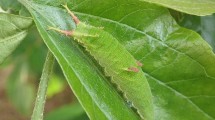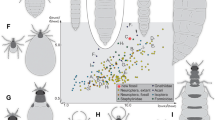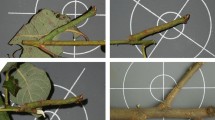Abstract
Hypolimnas bolina is a sexually dimorphic nymphalid butterfly with a west to east distribution from Madagascar to Easter Island, and north to south from Japan to Australasia. To the west the female is monomorphic, mimicking species of the oriental and Australasian danaid genus Euploea1. Eastwards H. bolina is frequently polymorphic and most forms are then non-mimetic. In areas where it resembles Euploea the butterfly has usually been designated a Batesian mimic. The supposed model feeds on Asclepiadaceae and Moraceae only, two families of plants of which various species possess emetic, toxic and purgative properties, whereas the foodplants of Hypolimnas include examples from eleven families, only a few of which are irritant or toxic2. We now report that when the larva of H. bolina feeds on Ipomoea batatas, the butterfly stores cardio-active substances. Dried specimens of this butterfly, reared on Asystasia gangetica, a plant which does not contain these substances (Table 1), evoke no reaction on isolated rat heart, but living specimens produce a slight response. This indicates that in addition to material sequestered from foodplants, the butterfly itself secretes some type of cardioactive substance. A loss of intrinsic toxic qualities after death has been demonstrated in almost all aposematic model Lepidoptera3, whereas stored secondary plant substances can usually be recorded from an analysis of dried material.
This is a preview of subscription content, access via your institution
Access options
Subscribe to this journal
Receive 51 print issues and online access
$199.00 per year
only $3.90 per issue
Buy this article
- Purchase on Springer Link
- Instant access to full article PDF
Prices may be subject to local taxes which are calculated during checkout
Similar content being viewed by others
References
Clarke, C. A. & Sheppard, P. M. Phil. Trans. R. Soc. B 272, 229–265 (1975).
Common, I. F. M. & Waterhouse, D. F. Butterflies of Australia (Angus & Robertson, Sydney, 1972).
Marsh, N. & Rothschild, M. J. Zool., Lond. 174, 89–122 (1974).
Langendorff, O. Arch. ges. Physiol. 65, 355–400 (1897).
Reichstein, T., von Euw, J., Parsons, J. A. & Rothschild, M. Science 161, 861–866 (1968).
Roeske, C. N., Seiber, J. N., Brower, L. P. & Moffitt, C. M. in Recent Advances in Phytochemistry 10 (eds Wallace, J. W. & Mansell, R. L.) 93–167 (Plenum, London & New York, 1975).
Rothschild, M., von Euw, J., Reichstein, T., Smith, D. A. S. & Pierre, J. Proc. R. Soc. B 190, 1–31 (1975).
Brower, L. P., Edmunds, M. & Moffitt, C. M. J. Ent A 49, 183–196 (1975).
Rothschild, M. in Insect/Plant Relationships (ed. van Emden, H. F.) 59–83 (Blackwell, Oxford, 1972).
Bullini, L. & Sbordoni, V. Boll. Zool. 38, 502 (1971).
Webb, L. J. Guide to Medicinal and Poisonous Plants of Queensland Bull. no. 232 (Council of Industrial and Scientific Research, Melbourne, 1943).
Hurst, E. The Poisonous Plants of New South Wales (Poison Plants Committee, New South Wales, Sydney, 1942).
Kirkhar, K. R. Poisonous Plants of Bombay (Private circulation, 1896).
Pavan, M. Gli Iridoidi negli Insetti. Pubbl. Ist. ent. Agraria Univ. Pavia 2, 1–49 (1975).
Bernardi, G. Proc. Sixteenth Congr. Zool., Washington 4, 161–166 (1963).
Pierre, J. Arch. Zool. exp. Gen. 114, 73–96 (1973).
Smith, D. A. S. Biol. J. Linn. Soc. 8, 183–204 (1976).
Author information
Authors and Affiliations
Rights and permissions
About this article
Cite this article
MARSH, N., CLARKE, C., ROTHSCHILD, M. et al. Hypolimnas bolina (L.), a mimic of danaid butterflies, and its model Euploea core (Cram.) store cardioactive substances. Nature 268, 726–728 (1977). https://doi.org/10.1038/268726a0
Received:
Accepted:
Issue Date:
DOI: https://doi.org/10.1038/268726a0
This article is cited by
-
The genetics of the butterfly Hypolimnas misippus (L.): The classification of phenotypes and the inheritance of forms misippus and inaria
Heredity (1987)
-
Plant-determined variation in the cardenolide content, thin-layer chromatography profiles, and emetic potency of monarch butterflies,Danaus plexippus reared on the milkweed,Asclepias eriocarpa in California
Journal of Chemical Ecology (1982)
-
Pyrrolizidine alkaloid storage in African and australian danaid butterflies
Experientia (1979)
-
Cardioactive substances in the monarch butterfly and Euploea core reared on leaf-free artificial diet
Nature (1978)
-
The effect of cardiac glycoside storage on growth rate and adult size in the butterflyDanaus chrysippus (L.)
Experientia (1978)
Comments
By submitting a comment you agree to abide by our Terms and Community Guidelines. If you find something abusive or that does not comply with our terms or guidelines please flag it as inappropriate.



